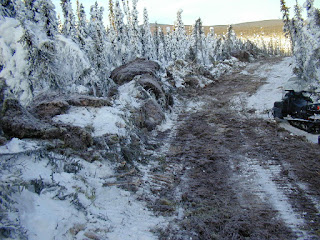Here's your science lesson for today...
About fifteen years ago, in the early to mid-aughts, there were a lot of forest firses around here. The local government, in it's infinite wisdom, decided to clear large areas of black spruce for fire breaks. This was done by shear blading. Shear-blading involves the use of a track dozer with a blade that shears the trees off at ground level during the winter months when the ground is frozen. The blade is supposed to float along the ground surface leaving the vegetative mat largely undisturbed.
When clearing a series of fire breaks in the Smallwood Creek valley behind our place, the dozer operator apparently got lost and followed our dog trail, widening and clearing the trail as he went.
The trail after shear blading. The large mounds on the left are the vegetative mat that was stripped off, rolled up, and pushed off to one side. The Ski Doo is parked on the other side on the original trail.
One of the gullies that formed out in the valley after shear blading. It's maybe 20-30 feet wide, up to 10 feet deep, and extends for the length of the cleared area. It can be a challenge to cross with a dog team or even a snow machine.
One of the usual results of surface disturbance to permafrost soils is thermokarst. Karst is a term that's usually applied to limestone sinkholes, but up here it's used to describe the consequences of permafrost degradation. This is evidenced by dips, hollows or gullies produced by the melting of ground ice and subsequent subsidence of the ground surface. A year or so after the clearing, forgot when, a pond began to form next to the trail right where the Ski Doo was parked in the first photo. Since numerous ponds and gullies were forming out in the valley where the clearing was also done, we were concerned that the erosion would get worse, maybe even making the trail un-runnable. While the state's contractor had attempted to reclaim the damage, we've been keeping an eye on it, even covering the pond with moss and leaves in the spring to keep it frozen longer into the summer.
So we hiked out there yesterday to check it out, we hadn't seen the pond unfrozen or without snow cover in quite a while. Surprisingly, it's apparently revegetated and stabilized, now it's just a little "tundra pond." Hopefully it'll stay that way!








No comments:
Post a Comment